|
Location Discovered |
Balkans |
| Material
|
Bronze/Copper Alloy/Lead |
|
Dimensions |
Main Panel: 8.1cm x 4.6cm
Secondary Panel: 7.8cm x 3.9
cm
Slate Base: 8.8cm x 5.5cm
Three Handled Plates: ~3.6cm
x 2.3cm
Lock plate: 4.6cm x 1.7cm
Edging Piece: 8.9cm x 1.9cm
(5mm thick)
Holed Edging: 6.0cm x 1.9cm
(4mm thick) |
|
Roman Empire |
1st
to 3rd
Century AD |
|
Description |
|
Various pieces of a smaller Roman bronze box, including two decorated
panel plates or covers as well as edging pieces and three small hinged
handles. A soft slightly encrusted patina covers all of the pieces.
Also included in the set
is a segment of the lock panel and a shaped piece of slate.
This is believed to have been a delicate and small Roman box. The
small handles with hinges as well as the engraved panels indicates that
this was no ordinary box. Speculation indicates that it either was a
jewelry box or possibly a make-up container. The piece of slate with
the angled and shaped edges appears to have either acted as the base for
the box, or may have been something that was stored inside of it.
Possibly used to mix makeup powder on it before it was applied.
Main Panel:
Bronze plate with a rectangular engraved design on one side. The
design consists of various lines forming numerous rectangles that
continuously get smaller, forming a thin rectangle in the center.
One side has a square notch cut out of it, perhaps indicating where it was
once held in place connected with another piece. The reverse side
has a slight clear border visible. This is believed to be the
remnants of some kind of edging that would have held it in place.
Secondary Panel:
Bronze plate with a lesser engraved design. The design consists of
various lines forming two overall rectangles that form squares in the
corners. The center area is clear of design. The corner edges
of the plate have been cut on all the sides, perhaps to allow it to sit in
the setting better.
Both the reverse and front side has a defined border visible, which is
grey in color. This is believed to be the remnants of some kind of
edging that would have held it in place against perhaps a wooden
background. The grey color could be an indication of lead which may
have formed the material holding it in place.
Slate Base:
A
slate/stone panel with one flat side, and the other with slanted edges.
Small amounts of encrustations remain attached to some of the sides.
Three Handled Plates:
Three nearly identical hinged and handled plates. These extremely
delicate plates are highly decorated, each with a small Roman Style handle
which is attached to to the indented plate by two small bent over pins.
The top of the plate has the remnants of two hinges which would have
attached to another surface to facilitate the movement of these plates.
Each plate has two rectangular line patterns inside, which is essentially
identical to the Secondary Plate design (only smaller).
Lock Plate:
This small lock plate indicating a vertical slot for a small key or latch.
One edge is folded over to re-enforce it while the reverse has a clear
indication of some kind of border. This may have been the remainder
of the lock or latch housing that is now gone. Again a grey color is
present perhaps indicating a lead content. Another impression also
exists on the reverse perhaps indicating that there were once other
components to the mechanism.
Edge Pieces:
This component appears to be part of the lid of the box, or edge. On
the interior surface an iron bar is visible. This bar appears to
re-enforce the edge of the lid and provide it with some weight. A
small area of lead "solder" is visible in the center holding the
Iron bar in place. The remainder of the edging pieces do not have an
iron bar component, however clearly were also of similar construction.
Some complete examples of similar Roman Boxes. These are from
museums and were most likely used for medicinal purposes. They also
could have been used to store a Stylus or other writing instruments as
well as cosmetic implements.
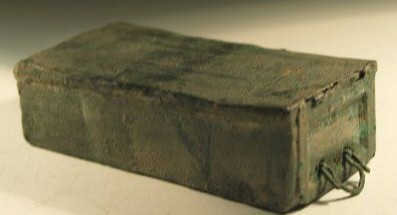 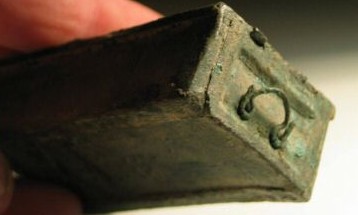
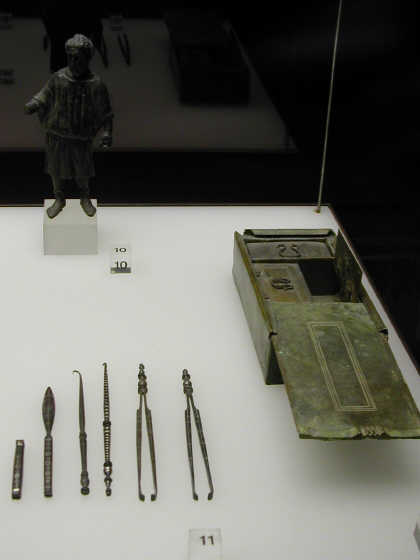 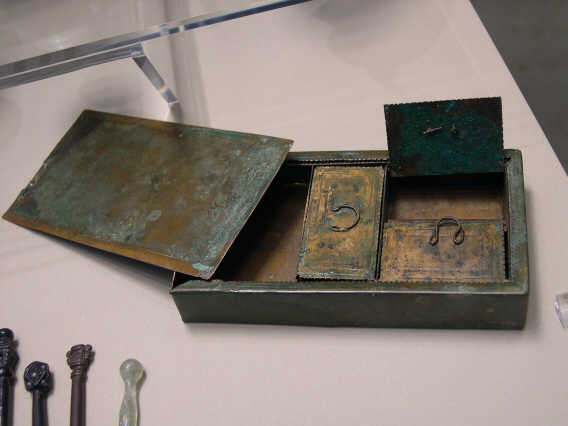
Click on
Pictures for higher resolution
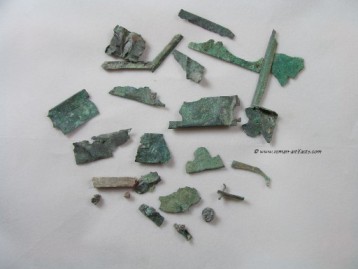
Fragment View |
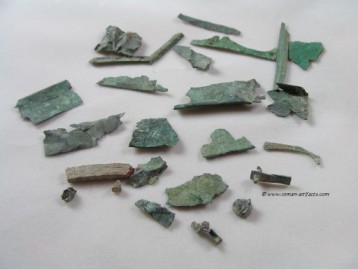
Fragment View
II |
| 